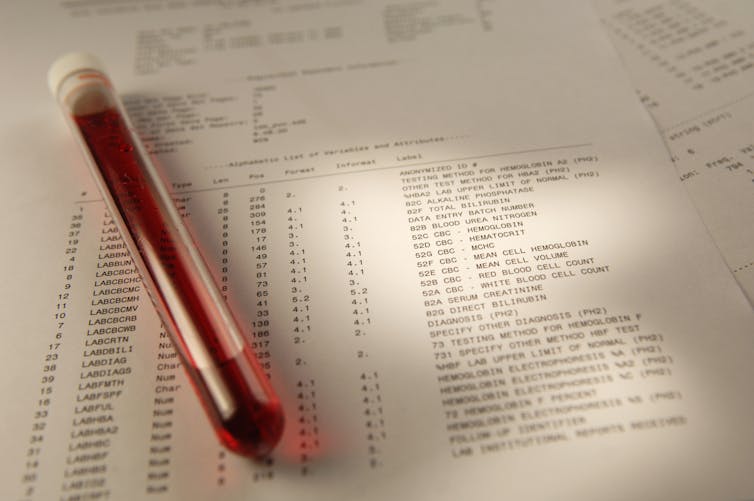If you’ve ever had a doctor order a blood test for you, chances are that they ran a complete blood count, or CBC. One of the most common blood tests in the world, CBC tests are run billions of times each year to diagnose conditions and monitor patients’ health.
But despite the test’s ubiquity, the way clinicians interpret and use it in the clinic is often less precise than ideal. Currently, blood test readings are based on one-size-fits-all reference intervals that don’t account for individual differences.
I am a mathematician at the University of Washington School of Medicine, and my team studies ways to use computational tools to improve clinical blood testing. To develop better ways to capture individual patient definitions of “normal” lab values, my colleagues and I in the Higgins Lab at Harvard Medical School examined 20 years of blood count tests from tens of thousands of patients from both the East and West coasts.
In our newly published research, we used machine learning to identify healthy blood count ranges for individual patients and predict their risk of future disease.
Clinical tests and complete blood counts
Many people commonly think of clinical tests as purely diagnostic. For example, a COVID-19 or a pregnancy test comes back as either positive or negative, telling you whether you have a particular condition. However, most tests don’t work this way. Instead, they measure a biological trait that your body continuously regulates up and down to stay within certain bounds.
Your complete blood count is also a continuum. The CBC test creates a detailed profile of your blood cells – such as how many red blood cells, platelets and white blood cells are in your blood. These markers are used every day in nearly all areas of medicine.

peepo/E+ via Getty Images
For example, hemoglobin is an iron-containing protein that allows your red blood cells to carry oxygen. If your hemoglobin levels are low, it might mean you are iron deficient.
Platelets are cells that help form blood clots and stop bleeding. If your platelet count is low, it may mean you have some internal bleeding and your body is using platelets to help form blood clots to plug the wound.
White blood cells are part of your immune system. If your white cell count is high, it might mean you have an infection and your body is producing more of these cells to fight it off.
Normal ranges and reference intervals
But this all raises the question: What actually counts as too high or too low on a blood test?
Traditionally, clinicians determine what are called reference intervals by measuring a blood test in a range of healthy people. They usually take the middle 95% of these healthy values and call that “normal,” with anything above or below being too low or high. These normal ranges are used nearly everywhere in medicine.
But reference intervals face a big challenge: What’s normal for you may not be normal for someone else.
Nearly all blood count markers are heritable, meaning your genetics and environment determine much of what the healthy value for each marker would be for you.
At the population level, for example, a normal platelet count is approximately between 150 and 400 billion cells per liter of blood. But your body may want to maintain a platelet count of 200 – a value called your set point. This means your normal range might only be 150 to 250.
Differences between a patient’s true normal range and the population-based reference interval can create problems for doctors. They may be less likely to diagnose a disease if your set point is far from a cutoff. Conversely, they may run unnecessary tests if your set point is too close to a cutoff.
Defining what’s normal for you
Luckily, many patients get blood counts each year as part of routine checkups. Using machine learning models, my team and I were able to estimate blood count set points for over 50,000 patients based on their history of visits to the clinic. This allowed us to study how the body regulates these set points and to test whether we can build better ways of personalizing lab test readings.
Over multiple decades, we found that individual normal ranges were about three times smaller than at the population level. For example, while the “normal” range for the white blood cell count is around 4.0 to 11.0 billion cells per liter of blood, we found that most people’s individual ranges were much narrower, more like 4.5 to 7, or 7.5 to 10. When we used these set points to interpret new test results, they helped improve diagnosis of diseases such as iron deficiency, chronic kidney disease and hypothyroidism. We could note when someone’s result was outside their smaller personal range, potentially indicating an issue, even if the result was within the normal range for the population overall.
The set points themselves were strong indicators for future risk of developing a disease. For example, patients with high white blood cell set points were more likely to develop Type 2 diabetes in the future. They were also nearly twice as likely to die of any cause compared with similar patients with low white cell counts. Other blood count markers were also strong predictors of future disease and mortality risk.
In the future, doctors could potentially use set points to improve disease screening and how they interpret new test results. This is an exciting avenue for personalized medicine: to use your own medical history to define what exactly healthy means for you.




